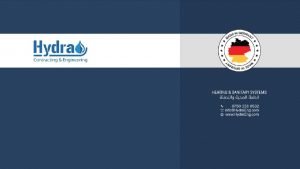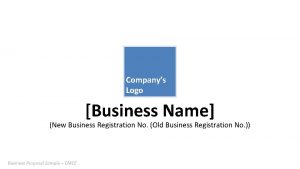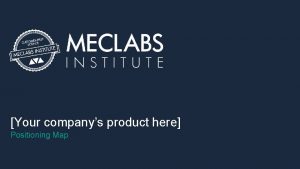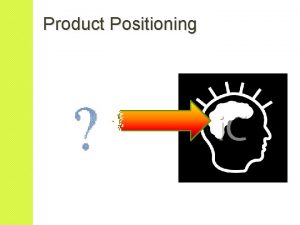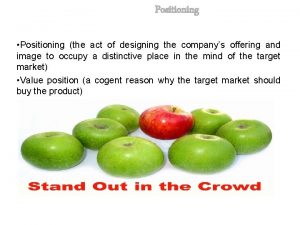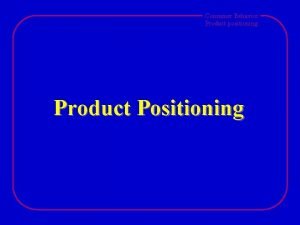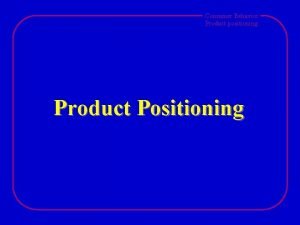Your companys product here Positioning Map Three Ways
![[Your company’s product here] Positioning Map [Your company’s product here] Positioning Map](https://slidetodoc.com/presentation_image_h/8e9931bc02a82d764cec05bba16f3150/image-1.jpg)









- Slides: 10
![Your companys product here Positioning Map [Your company’s product here] Positioning Map](https://slidetodoc.com/presentation_image_h/8e9931bc02a82d764cec05bba16f3150/image-1.jpg)
[Your company’s product here] Positioning Map

Three Ways to Create a Positioning Map 1 SEGMETNATION MAP, TWO AXIS 2 POSITIONING MAP, 3 -4 VARIABLES 3 COMPETITIVE LANDSCAPE MAP Determine two measurable dimensions or determinant attributes (can be quantity or quality) that will indicate who competes closest to you. A quantifiable axis may be revenue or site visits. A qualitative metric may be perception it the marketplace. Process is similar to the segmentation map, but instead of plotting points with “dots, ” you utilize shape to show a second dimension. These can sometimes be called, “bubble maps. ” You may plot price and age demographic (both low to high), then each dot is a different size representing company revenue, or vary in color. This map is designed for companies with a diverse product offering who compete with many different types of companies. For example, Facebook competes with Google, Twitter, and Web. com.

PROCESS To segment the competitors, follow a 3 step process: 1. Identify attributes 2. Gather and organize data 3. Segment Why do we segment competitors? • Segmenting competitors enables you to perceive and take advantage of differences between product offerings to better meet the needs and increase the conversion of customers visiting your site • A segmentation of competitors will help indicate what currently drives success in the industry and may lend insights into your company’s unique value proposition

STEP ONE Step 1: Identify Attributes • To begin segmenting competitors, you must identify which attributes of your product offering are determinant attributes • A determinant attribute must: • Help customers differentiate between competitors (i. e. value presentation) • Help customers determine product offering they prefer • Relevant data may help illustrate current customer preferences (i. e. traffic levels) • Basically, a determinant attribute must help customers determine their preference OR illustrate the preference of current customers

STEP ONE Step 1: Identify Attributes • Choosing the determinant attributes • Traditionally when conducting a competitive analysis, we try to narrow down the potential determinant attributes to the two that the target consumer may value the most or that are indicative of current success of the competitor • Example attributes: • Traffic Volume - Good indicator of current success and popularity • Similar. Web - provides an estimate of current traffic volume • Alexa - provides a traffic ranking compared to other sites • Revenue • Price • Value Presentation - Helps customers differentiate between competitors and is a good indicator of a competitor whose analysis will yield valuable insight • BUT… These attributes are not always relevant or available and therefore we must often look for other attributes to examine

STEP TWO Step 2: Gather and organize data • Segmenting by quantitative attributes such as traffic or revenue is straight forward • But to segment by value presentation, you must first evaluate the value presentation score • To determine value presentation score, rate 3 factors on a scale of 1 -5. The total of the 3 is the value presentation score • Exclusivity: unique benefit(s) no other competitor offers. Why should someone buy from you? i. e. Price advantage, simplicity of service, award winning service, etc • Credibility: Using either third party sources to validate claims (testimonials, awards, etc. ) or quantitative data and proven track record, to strengthen argument • Clarity: Demonstrating value and credibility in clear and concise manner that effectively communicates to the user. User can digest value content quickly and efficiently.

SEGMETNATION MAP, TWO AXIS Observations • Point of analysis High 350, 000+ i. Stock Photo Shutterstock Fotosearch Dreamstime depositphoto 123 rf • Point of analysis Unique Visitors • Point of analysis Getty Images Low fotolia Super. Stock bigstockphoto Veer Corbis Images Alamy Image. Source Blend. Images 0 Low Thinkstockphotos RGB Stock. Fresh Value Proposition Communication Score 5 High

POSITIONING MAP, 3 -4 VARIABLES Observations • Point of analysis High • Point of analysis 120, 000 Pimsleur • Point of analysis 90, 000 Pimsleur Unique Visitors • Point of analysis Busuu Transparent Language 60, 000 LEGEND • Bubble size: number of languages offered • Color: competitor business model • One-time buy • Subscription • Color shade: Value presentation score • Light colors = weak VPS • Strong colors = strong VPS Rosetta Stone Mango Languages 30, 000 Voxy Ouino Low Berlitz $0 Low Michael Thomas $1, 200 Price High

Competitive Landscape Map Direct Competition ● Dovico ● Cyma ● Bell. Wether. Corp ● Peachtree ● Asapsystems ● Fishbowl ● Avidian (Net. Suite) Accounting Inventory ● Clearly. Inventory ● Gigatrak Full Service ● Net. Suite Point of analysis ●Spend. Map (Sage) ● Open. Air Payroll ●Sage. Abra (Sage) ● Syspro ● SAP Point of analysis Invoicing Quickbooks ● Harris. Data Point of analysis Sales & Expenses Company X ● • • ● Certify ● Intacct ● Sage. MAS (Sage) ●Kronos ●Sure Payroll (Net. Suite) Indirect Competition • • Point of analysis

Two Ways to Improve your Competitive Position Call for Research Partners Online Certification Courses We are currently building our 2017 research calendar and are looking for companies focused on finding out why customers say “yes” in the areas of subscription, lead gen, nonprofit and ecommerce. Get the certified in MECLABS Institute’s patented methodology for website optimization and value proposition development. To learn more, visit: MECLABS. com/Partners To learn more, visit: MECLABS. com/Courses

